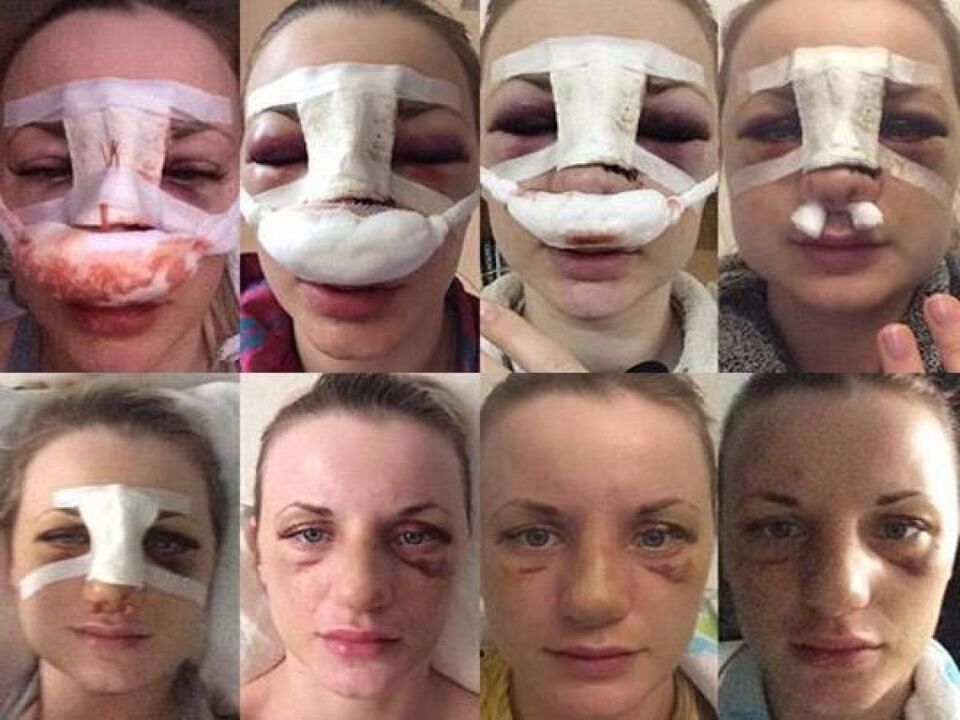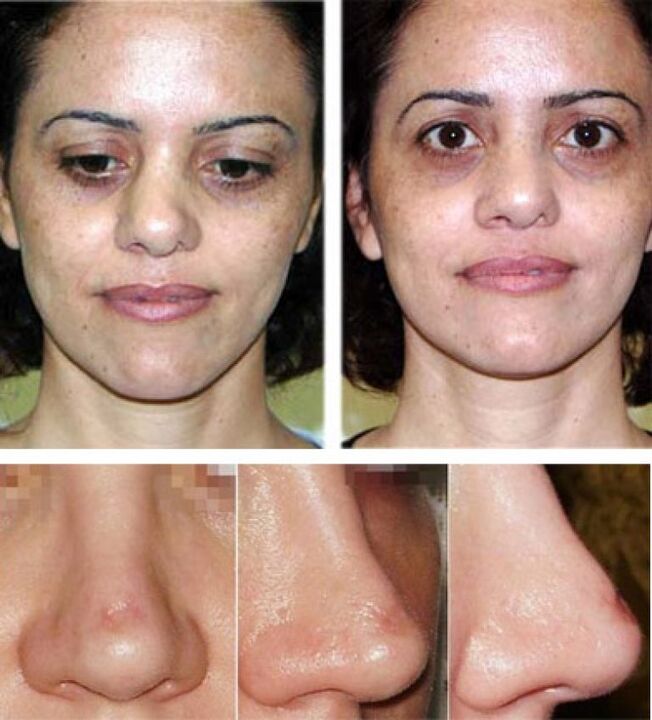Rhinoplasty is a major surgical procedure. It is often the case that the result after a rhinoplasty is not always what we want. And this requires a second surgery. Rhinoplasty is considered to have failed if it has not produced the desired effect or exacerbated the patient's condition. He must be treated very responsibly. Excessive swelling can be achieved with incorrect correction of the shape of the nose, loss of smell, curvature of the septum, and difficulty in the breathing process. Therefore, before rhinoplasty, you should know that the result may be different from what you want.

Possible complications
Unfortunately, it is quite difficult to predict how rehabilitation will take place. Not even the most experienced doctor can tell you exactly what your body’s reaction will be. Therefore, plastic jewelry and rhinoplasty are considered filigree. The consequences after surgery can be irreversible, and any potential risks should be reasonably assessed in preparation for such an intervention.
The most likely side effects of rhinoplasty are:
- bleeding from the nose;
- hyperpigmentation at the site of exposure;
- disorders of lymphatic and blood flow leading to edema and hematomas;
- abscesses;
- bleeding in the operated and approach zones;
- complete or partial loss of odor;
- difficulty breathing due to swelling of the mucous membranes;
- the curvature of the nasal septum;
- excessive formation of scar tissue, which ensures the formation of a voluminous scar;
- inflammatory processes in soft tissues.
The occurrence of the above signs characterizes unsuccessful surgery.
Causes of complications
Knowing the possible causes of complications after plastic surgery makes it much easier and safer for the body to prevent them.
Lack of experience
The most common prerequisite for the side effects of rhinoplasty is a low level of education of the surgeon. Insufficient experience causes the doctor to ignore certain mandatory points. In addition, the impact of small-scale development of practical skills is possible. They are especially important in rhinoplasty. The nose has a very complex structure and even the slightest mistake can have irreversible consequences.
Wrong choice of technique
An inexperienced doctor is not necessarily wrong. Experienced surgeons also make mistakes, and this happens much more often than we would like. This is due to the fact that there are several techniques for rhinoplasty. Each is the most optimal for patients with certain anatomical features according to the desired goals. Improper choice of rhinoplasty surgery techniques can also lead to serious results that in most cases cannot be eliminated.
Disorders of postoperative care
A successful plastic surgery is only half the positive result. The second part falls into the healing period. At this time, the patient’s behavior will be what will be very important. Failure to follow medical recommendations may result in edema, hematomas, and active scarring of the tissue. The doctor performing the plastic surgery can usually give you an idea of exactly how the rehabilitation will take place and tell you what tools can be used to reduce it.
Patients often ignore the advice of a specialist before plastic surgery, based on their friendly experiences or their own subjective feelings. And this attitude is characterized by deterioration, the appearance of pigment spots, persistent swelling and other unpleasant side effects that are characteristic of failed rhinoplasty.

How to avoid complications?
Anyone would rather prevent the problem than solve it. In the case of rhinoplasty, this is an absolutely and absolutely right decision. Minimizing risks not only helps you achieve the best quality results. It makes it possible to avoid side effects and makes recovery as easy as possible.
- Selection of doctor and clinic. It is best to choose a professional whose "portfolio" has the opportunity to "get to know" live. This will help you see how much you can embody the wishes of your patients, to form a comprehensive picture of professionalism. You can also read the opinions of those who have had a rhinoplasty at your chosen clinic and from a particular doctor. To do this, you need to spend some time trying to find information about the surgeon, the anesthesiologist, in the reviews. The selection should not be guided only by the reviews on the "native" site - they are usually moderated and not all of them can be published. The excellent results are shown by the visual photos before and after the rhinoplasty.
- Creating the most accurate project. In order for the surgeon to better understand what the patient wants, modern medicine uses computer-aided design. After setting the basic parameters of the face, the program allows you to perform it as close as possible to the natural correction. This way you can see how satisfied you will be with the expected results of the rhinoplasty. The doctor, for his part, may assess the possibility of carrying it out and, if necessary, suggest alternative options. But it should be borne in mind that such a design may not always take into account all the anatomical features and therefore cannot guarantee full compliance with the desired result.
- Strict adherence to recommendations before and after plastic surgery. Contrary to popular belief, preparing for an intervention is very important. It helps determine the extent of scarring during remission, and predicts the development of hematomas and edema. Therefore, consult your doctor before following a rhinoplasty and follow all his advice exactly. Postoperative care minimizes side effects by reducing pain, swelling, and scarring after rhinoplasty.

The result becomes fully visible after 6-8 months. Up to this point, small swellings and edema may occasionally appear and disappear. Do not panic before the term - lymph flow and blood flow do not recover immediately, so for some time there may be side effects after rhinoplasty.

Renovation
After plastic surgeries, patients occasionally want to correct the shape of their nose. Where possible, this will allow for the recovery of violations identified during the implementation of a failed plastic surgery.
There are many complexities to this intervention. The repeated procedure after a failed rhinoplasty is in most cases much more serious than the first. At this stage, the shape of the nose is already corrected from the amount of tissue available. This can make the surgeon's job significantly more difficult. Such rhinoplasty does not guarantee the full achievement of the desired result at all. Therefore, you will need to see more doctors first.
Corrective rhinoplasty is performed if the patient has minor defects. It is performed under local anesthesia and should be nothing more than an adjustment to a fully finished version. Typically, these include rhinoplasty and scar removal.

Non-surgical correction is also performed in the absence of serious lesions after unsuccessful surgery. It is performed under local anesthesia and may also contain fillers. If necessary, they help to "fill in" the formed depressions and unevenness, to highlight the cartilage and to correct the angles.
Contouring is also aimed at filigree correction of nose details. This involves the use of hyaluronic acid, which forms a special "frame" for the skin and tissues. It can be used to correct nose details, angles and asymmetry.
General recommendations
- Rhinoplasty is a very serious and responsible step. When you agree to an operation, you should be aware that it is impossible to restore everything to its previous state. Therefore, it is very important to be psychologically prepared to perform the intervention and to wait six months for the end result to completely disappear.
- The choice of clinic and surgeon plays a very important role in performing quality nasal surgery. Before going to a meeting, read the reviews on the network. The more information there is before the rhinoplasty, the easier the decision. You shouldn’t focus on loud advertising - it often hides low professionalism, a number of additional mandatory paid services, and not the best attitude toward customers.
- During the first consultation, try to describe to the doctor as accurately as possible the desired outcome of the plastic surgery. This will help him navigate better and work out the "front of the job. " Understanding the desired result by the surgeon will help achieve the most accurate result.
- An experienced surgeon will certainly clarify the presence of breathing problems, allergic reactions, past illnesses and medications being taken. This will help to compile the most complete clinical picture from which to choose drugs and methods of influence during rhinoplasty. It is worth noting that if a doctor does not provide such information, this is a very alarming sign that is typical of low-skilled professionals.






















